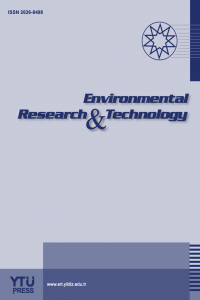Application of IWA standard water balance in strategic water loss analysis: Benefits and problems
Water losses occurring in distribution systems have effect on the operating cost, water and energy efficiency, service quality, customer satisfaction, maintenance and new resource demand. The standard water balance recommended by International Water Association (IWA) were used for defining, analyzing, regularly monitoring the water balance and sub-components, and determining the weakness and strengths of system. Water Utilities in Turkey are required to fill the water balance annually in order to analyze and monitor the performance with the regulation published in year 2014. However, in the use of this table, important problems are experienced due to the lack of technical, technological, personnel and economic conditions, data representing the field are not used and in many cases the real performance of the system is not revealed. In this study, the importance of IWA water balance in water loss management and monitoring system performance is emphasized, and the benefits and advantages are detailed by analyzing the pilot regions. In addition, problems encountered during filling the water balance, mistakes made, incomplete or incorrectly filled data and other problems were discussed. It is thought that this study will constitute a reference for the technical personnel in Utilities for measuring the data, analyzing the components and interpreting the results.
___
- REFERENCES [1] Lambert, A. O., T. G. Brown, M. Takizawa, and D. Weimer. 1999. “A Review of Performance Indicators for Real Losses from Water Supply Systems.” Journal of Water Supply: Research and Technology - AQUA. Vol. 48(6), pp. 227-237.
- [2] Farley, M., G. Wyeth, Z.B.M. Ghazali, A. Istandar, and S. Singh. 2008. The Manager’s Non-Revenue Water Handbook. A Guide to Understanding Water Losses.
- [3] Liemberger, R., B. Kingdom, and P. Marin. 2006. “The Challenge of Reducing Non-Revenue Water (NRW) in Developing Countries.” The World Bank,Water Supply & Sanitation Sector Board, PPIAF 8: 1–40.
- [4] Liemberger R, Farley M (2004) Developing a Non-Revenue Water Reduction Strategy Part 1 : Investigating and Assessing Water Losses. Proc IWA 4th World Water Congress and Exhibition, 19-24 September 2004 Marrakech Morocco 1–10
- [5] Farah E, Shahrour I (2017) Leakage Detection Using Smart Water System: Combination of Water Balance and Automated Minimum Night Flow. Water Resources Management. Vol. (31), pp. 4821-4833
- [6] Mutikanga, H. M., Sharma, S. K. and Vairavamoorthy, K. (2011) ‘Assessment of apparent losses in urban water systems’, Water and Environment Journal, Vol. 25, pp. 327–335.
- [7] Xin K, Tao T, Lu Y, Xiong X, Li F. 2014. Apparent Losses Analysis in District Metered Areas of Water Distribution Systems. Water Resour Manag. Vol. (28), pp. 683–696.
- [8] Lipiwattanakarn S. et al. (2019). Real benefits of leak repair and increasing the number of inlets to energy. Water Science & Technology, Vol. 14(3), pp. 714–725.
- [9] Creaco E. et al. (2019) Real time control of water distribution networks: A state-of-the-art review. Water Research, Vol. 161, pp. 517–530.
- [10] Boztaş F., Özdemir Ö., Durmuşçelebi F.M., Firat M. (2019) Analyzing the effect of the unreported leakages in service connections of water distribution networks on non-revenue water. International Journal of Environmental Science and Technology. Vol. (16), pp. 4393-4406.
- [11] Yazdekhasti, S., Piratla, K.R., Sorber, J., Atamturktur S. (2020). Sustainability Analysis of a Leakage-Monitoring Technique for Water Pipeline Networks. Journal of Pipeline Systems Engineering and Practice. Vol. 11(1),
- [12] Jafari-Asl J., Kashkooli B.S., Bahrami M. (2020). Using Particle Swarm Optimization Algorithm to Optimally Locating and Controlling of Pressure Reducing Valves for Leakage Minimization in Water Distribution Systems. Sustainable Water Resources Management. Vol. 6, article number 64.
- [13] Fallis P, Hübschen K, Oertlé E, et al (2011) Guidelines for Water Loss Reduction. 236
- [14] Lambert, A., B. Charalambous, M. Fantozzi, J. Kovac, A. Rizzo, and S. Galea St. John. 2014. “14 Years Experience of Using IWA Best Practice Water Balance and Water Loss Performance Indicators in Europe.” Proceedings of the WaterLoss Conference 2014.
- [15] Farley M, Liemberger R (2005) Developing a non-revenue water reduction strategy: planning and implementing the strategy. Water Science and Technology: Water Supply. Vol. 15, pp. 41–50.
- [16] MASKİ (2018). Malatya Water and Sewerage Administration.
- Yayın Aralığı: Yılda 4 Sayı
- Başlangıç: 2018
- Yayıncı: Yıldız Teknik Üniversitesi
Sayıdaki Diğer Makaleler
Asude HANEDAR, Burak GÜL, Elçin GÜNEŞ, Gül KAYKIOĞLU, Yalçın GÜNEŞ
Meryem AKSU, Pınar Nazire TANATTI, Büşra ERDEN, İsmail Ayhan ŞENGİL
Salih YILMAZ, Özgür ÖZDEMİR, Mahmut FIRAT
Benan YAZICI KARABULUT, Perihan DERİN, Mehmet İrfan YEŞİLNACAR, Mehmet Alı ÇULLU
Özge KILIÇ, Sadullah Levent KUZU
Fatma EKMEKYAPAR TORUN, Şahset İRDEMEZ, Sinan KUL, Yaşar NUHOĞLU
Marcelino Jr LUNAG, Melissa May BOADO
Md. Ashik AHMED, Pranta ROY, Md. Hakimuzzaman SHAH, Debobrata Paul ARGHA, Debbrata DATTA, Riyadul Hashem RİYAD
